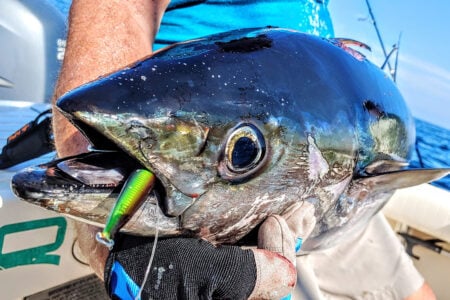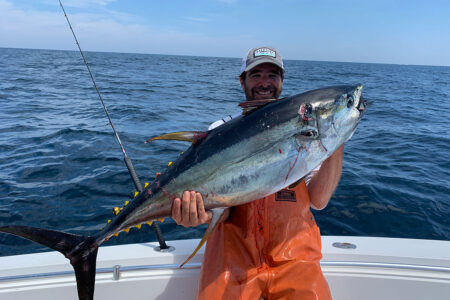
What does it take to run a small boat offshore to tangle with tuna?
What does it mean when someone says “south of Block” when giving you an offshore fishing report? Most people don’t even have an “accurate sense of direction” to begin with, and that general direction is, essentially, endless miles of open ocean. So, what exactly does it mean to go tuna fishing, south of Block Island? I will try my best to put things in perspective.
First, there are a handful of areas within the definition of ‘south of Block Island’ that offer world class fishing, including Southwest Ledge, with its EPIC striped bass fishery and even the unbelievable bottom fishing just a few miles south of Block and in the area surrounding the windmills, but that’s for another day and another article. If your target species is tuna; you’ll have shots at both bluefin and yellowfin in these fabled waters.

Going South
| ENDGAME |
| Casting at, hooking and gaffing a tuna is a major accomplishment, but the job isn’t done there. Now what? Let’s say, hypothetically, that you’re on a 21-foot bay boat, you have a 50-pound yellowfin, freaking out on your deck, and there’s blood everywhere. Absolute chaos! What should you do? First, kill the fish. Some anglers use a baseball bat to stun the fish, personally I think this is pathetic. Ike Jime is a more humane way to dispatch a tuna (or any fish species). This method, which originated in Japan, utilizes a special spike that is plunged into the fish’s brain, causing instant death. I also like to slice the fish behind the pectoral fins and hang it over the side of the boat with a tail rope, with about half of the fish in the water. This helps the fish bleed out properly so you can get the best table fare possible. After 10 to 15 minutes of hanging the fish I will core the entrails and fill the body cavity with crushed ice, and then stow it for best preservation. |
This “general area” starts about 10 miles south (or offshore) of Block Island and is about 25 nautical miles wide. If you can picture, or plot on a chart, the area within the following parameters, you’ll have a pretty good outline of the limits of what it means to fish south of Block. At the northwest corner we have Inner Butterfish Hole, and The Gully sits at the northeast corner. Heading south from there we encounter Jenny’s and Ryan’s Horns, this rounds out the southwest corner. Draw a straight line 25 miles east from there and you’ll encounter Tuna Ridge, Suffolk wreck and the Dump, this makes up the southeast corner of these well-known offshore tuna grounds. Some might also include the shipping lanes, further to the south as part of the “South of Block” designation, but this area “out of range” for most smaller boats, due to fuel capacity, among other dangerous reasons.
Due to this general area being only about 10 to 30 nautical miles offshore of Block Island and Rhode Island, it has become a very popular area for anglers running smaller (19 to 24-foot) boats to tuna fish within sight, and a day’s steam of Block Island, Long Island, Rhode Island and even Connecticut! This area also has a lot of structure, wrecks, changes in depth, current and is a staging ground for oceanic sand eels in the summer and fall months, among other species of baitfish. These two factors alone makes these waters worth the trip!
This area is very special, and unique in its own way and allows anglers with smaller vessels to get a taste of offshore fishing! The food sources available in this area are so dense most years, that they attract mammals of all kinds, including finback and humpback whales, bottlenose dolphin, other species of dolphin and, along with all these marine mammals are the tuna. Usually, the bluefin show up first in June and by July, the yellowfin begin to take over the show. This is when it gets fun!
Mammalian Cues
Each “spot” I’ve listed, have all had their moments of glory, but the reality of the situation is fish swim, they move. One day, the Gully is on fire, with bluefin and/or yellowfin tuna smashing sand eels on the surface for hours. You go back the next morning only to find no marks on the screen and a dead sea for miles in every direction.
| BASIC BLOCK BOUNDARIES |
| Inner Butterfish Hole 40.50.23 71.40.55
The Gully 41.00.00 71.23.00 Jenny’s Horn 40.48.50 71.32.65 Ryan’s Horn 40.45.20 71.27.70 Tuna Ridge 40.55.00 71.16.75 Suffolk Wreck 40.52.80 71.13.20 The Dump (NW Corner) 40.49.00 70.58.50 |
When I’m looking for tuna, I’m always looking for life, mostly mammals. And feeding birds too. A lot of times I will see acres of dolphin leaping and swimming at high speeds, all in unison. My first two trips I kept chasing these dolphin, thinking they were feeding with tuna, but once I realized the dolphin were constantly moving, it hit me… they were hunting, just like we were. I then went searching for a more “stationary” mammal feed and headed away from the fleet of boats.
On this day I ran toward the Suffolk Wreck and found just what I was looking for; dolphin, stationary and feeding on a bait ball. I knew there had to be tuna feeding with the dolphin as well. I came up onto the feed slowly and threw a popper into the feed, and on the second pop, I got absolutely smoked by a large yellowfin. I knew instantly by its sickles.
After a fun, nerve wracking battle we had the yellowfin gaffed boat side in under 15 minutes; pure euphoria! It truly was a moment that I will never forget for the rest of my life. So, burn a little extra fuel, don’t follow the fleet, and look for areas holding life and mammals that seem to be holding in the same general area, while feeding. Or, you may see the tuna themselves, completely airing out of the water. No matter what clue you see, don’t hesitate to make a cast, you really never know what might smash you plug. And get ready for an insane adrenalin rush! Which is why these runs are so worth it.

‘Sending It’ Safely
| NOT JUST TUNA |
| Sometimes the tuna just don’t want to play nice, but there are many other species available out there that, if you’re prepared to switch gears, can save the day. Mahi are common around any floating debris or buoys/gear. Skipjack tuna and false albacore are also present south of the island and both are exciting to catch on light to medium gear. A variety of shark species are also available, which can add an exciting end to a slow tuna trip if needed.
|
Tuna fishing, though exciting and addictive, can be dangerous. The runs to and from the grounds are long and usually in the dark and there are countless things that you must be prepared for. If you ask me, I would say your first trip should be with a USCG licensed captain so you can learn from a pro before giving it a try on your own boat. This will give you the opportunity to learn what you should and shouldn’t do. Things you need and things you don’t need, as well.
There is also a technical side to the safety precautions that should be taken, when ‘sending it’ south of Block Island. The first thing you should do is buy a PLB (Personal Locator Beacon) and/or an EPIRB. These devices, when wet, will send your personal current location to the US Coast Guard and search and rescue teams in an emergency. There are many different kinds of PLB and EPIRBS on the market. Some are better than others, and some even say they can narrow your search radius to 10 meters. The second checkmark that I like to make is the boat itself. Is everything working 100%? Not 99%, 100%! Check the engine, navigation lights, make sure your fire extinguisher is working and not outdated, and make sure your first aid kit is up to code. It’s also important to note that a NOAA HMS (Highly Migratory Species) permit is required for every vessel planning on harvesting tuna. Don’t leave the dock for a tuna trip without one, ever.
Tuna fishing can be frustrating, expensive, and hit or miss. Especially on spinning gear, casting poppers and jigs from a small vessel with very little room, makes things hard enough as it is. I took this trip at least three times before I really, finally figured it out. Meaning, hooking and landing my first yellowfin tuna on a popper, on my 19-foot bay boat. So, don’t get discouraged if you strike out a few times, before your moment of glory.
Also, like I said, fish with a pro before you do it on your own. Too many things can go wrong, you will be that much better prepared and your chances for success will increase exponentially. If it were easy, everyone would do it, but take it from me, all the prep, checklists and fuel costs, are worth it!





